Influence of Interlayer Bonding Conditions Between Base and Surface Layers on Structural Mechanics Response of Asphalt Pavements
Abstract
1. Introduction
2. Materials and Test Methods
2.1. Raw Materials and Mixture Ratio Design
- (1)
- Asphalt mixtures
- (2)
- Cement Stabilized Macadam
- (3)
- Preparation of interlayer shear specimen
2.2. Interlayer Shear Test
2.3. Layered Linear Elasticity Considering Interlayer Bonding
2.4. Analysis of the Influence of Interlayer Bonding on Pavement Structure
3. Analysis of Calculation Methods for Interlayer Adhesion Coefficient
4. Analysis of Interlayer Bonding Performance
5. Analysis of the Mechanical Response of Interlayer Bonding to Pavement
6. Analysis of Critical Values of Interlayer Bonding Coefficient
7. Conclusions
- (1)
- Analysis of shear stress–displacement relationships reveals peak shear stress occurs at 2–4 mm displacement—orders of magnitude greater than actual structural displacements (<0.002 mm) calculated via layered elastic theory. This validates the initial shear stress–displacement ratio as the appropriate bonding coefficient metric.
- (2)
- Oblique shear testing demonstrates significant inherent bonding without treatment, while tack coats substantially enhance performance. SBS-modified asphalt consistently outperforms other methods, providing 40–50% higher bonding strength than untreated interfaces and 15–20% higher than emulsified asphalt across all temperatures (20 °C, 35 °C, 50 °C). Material incompatibility reduces asphalt–CSM bonding effectiveness by 18–25% compared to asphalt–asphalt interfaces.
- (3)
- The CSM–asphalt interface critically governs pavement performance, particularly asphalt surface fatigue life. This interface exerts 3.2× greater influence on fatigue life than on permanent deformation. A bonding coefficient threshold of >5000 MPa/cm is required to achieve mechanical equivalence to fully bonded conditions.
Author Contributions
Funding
Conflicts of Interest
References
- Yang, K.; Li, R. Characterization of bonding property in asphalt pavement interlayer: A review. J. Traffic Transp. Eng. 2021, 8, 374–387. [Google Scholar] [CrossRef]
- Chen, S.; Wang, D.; Yi, J.; Feng, D. Analytical calculations for asphalt pavement considering interlayer performance. J. Transp. Eng. Part B Pavements 2022, 148, 04022022. [Google Scholar] [CrossRef]
- Liu, Y.; Qian, Z.; Gong, M.; Huang, Q.; Ren, H. Interlayer residual stress analysis of steel bridge deck pavement during gussasphalt pavement paving. Constr. Build. Mater. 2022, 324, 126624. [Google Scholar] [CrossRef]
- Wang, J.; Xiao, F.; Chen, Z.; Li, X.; Amirkhanian, S. Application of Tack Coat in Pavement Engineering. Constr. Build. Mater. 2017, 152, 856–871. [Google Scholar] [CrossRef]
- Wang, X.; Su, Z.; Xu, A.; Zhou, A.; Zhang, H. Shear fatigue between asphalt pavement layers and its application in design. Constr. Build. Mater. 2017, 135, 297–305. [Google Scholar] [CrossRef]
- Covey, D.; Coleri, E.; Mahmoud, A. Tack coat rheological properties and the effects on interlayer shear strength. J. Mater. Civ. Eng. 2017, 29, 04017221. [Google Scholar] [CrossRef]
- Pasetto, M.; Pasquini, E.; Giacomello, G.; Baliello, A. Innovative composite materials as reinforcing interlayer systems for asphalt pavements: An experimental study. Road Mater. Pavement Des. 2019, 20 (Suppl. 2), S617–S631. [Google Scholar] [CrossRef]
- Ragni, D.; Takarli, M.; Petit, C.; Graziani, A.; Canestrari, F. Use of acoustic techniques to analyse interlayer shear-torque fatigue test in asphalt mixtures. Int. J. Fatigue 2020, 131, 105356. [Google Scholar] [CrossRef]
- Raab, C.; Abd El Halim, A.O.; Partl, M.N. Interlayer bond testing using a model material. Constr. Build. Mater. 2012, 26, 190–199. [Google Scholar] [CrossRef]
- Raposeiras, A.C.; Vega-Zamanillo, Á.; Calzada-Pérez, M.A.; Castro-Fresno, D. Influence of surface macro-texture and binder dosage on the adhesion between bituminous pavement layers. Constr. Build. Mater. 2012, 28, 187–192. [Google Scholar] [CrossRef]
- Raposeiras, A.C.; Castro-Fresno, D.; Vega-Zamanillo, Á.; Rodriguez-Hernandez, J. Test methods and influential factors for analysis of bonding between bituminous pavement layers. Constr. Build. Mater. 2013, 43, 372–381. [Google Scholar] [CrossRef]
- Isailović, I.; Wistuba, M.P. Asphalt mixture layers’ interface bonding properties under monotonic and cyclic loading. Constr. Build. Mater. 2018, 168, 590–597. [Google Scholar] [CrossRef]
- Liu, M.; Han, S.; Pan, J.; Ren, W. Study on cohesion performance of waterborne epoxy resin emulsified asphalt as interlayer materials. Constr. Build. Mater. 2018, 177, 72–82. [Google Scholar] [CrossRef]
- Huang, H.; Zhan, Y.; Tao, Y.; Ai, C.; Ren, D.; Jin, D. Three-dimensional characterization of bonding features for asphalt pavement interface using a novel interlayer isolation film. Constr. Build. Mater. 2021, 311, 125301. [Google Scholar] [CrossRef]
- Rahman, A.; Huang, H.; Ai, C.; Ding, H.; Xin, C.; Lu, Y. Fatigue performance of interface bonding between asphalt pavement layers using four-point shear test set-up. Int. J. Fatigue 2019, 121, 181–190. [Google Scholar] [CrossRef]
- Ai, C.; Rahman, A.; Song, J.; Gao, X.; Lu, Y. Characterization of interface bonding in asphalt pavement layers based on direct shear tests with vertical loading. J. Mater. Civ. Eng. 2017, 29, 04017102. [Google Scholar] [CrossRef]
- Ye, H.; Wang, X.; Fang, N.; Su, Z.; Sun, X. Interlayer Working Conditions Classification and Treatment Measures of Airport Asphalt Pavement Overlay. J. Adv. Transp. 2019, 2019, 9646091. [Google Scholar] [CrossRef]
- Li, P.; Niu, T.F.; Zhang, Y.L.; MA, K. Study on Anti-shearing Property of Asphalt Pavement for Concrete Bridge Deck Based on Oblique Shear Test. J. Wuhan Univ. Technol. Transp. Sci. Eng. 2015, 39, 1071–1075. [Google Scholar] [CrossRef]
- De Jong, D.L. Computer Program Bisar, Layered Systems under Normal and Tangential Loads; Report assumed; Koninklijke/Shell Laboratorium: Amsterdam, The Netherlands, 1979. [Google Scholar]
- You, L.; Yan, K.; Hu, Y.; Ma, W. Impact of interlayer on the anisotropic multi-layered medium overlaying viscoelastic layer under axisymmetric loading. Appl. Math. Model. 2018, 61, 726–743. [Google Scholar] [CrossRef]
- Wu, S.; Chen, H.; Zhang, J. Effects of interlayer bonding conditions between semi-rigid base layer and asphalt layer on mechanical responses of asphalt pavement structure. Int. J. Pavement Res. Technol. 2017, 10, 274–281. [Google Scholar] [CrossRef]
- Maina, J.W.; De Beer, M.; Matsui, K. Effects of layer interface slip on the response and performance of elastic multi-layered flexible airport pavement systems. In Proceedings of the 5th International Conference on Maintenance and Rehabilitation of Pavements and Technological Control, Park City, UT, USA, 8–10 August 2007; pp. 145–150. [Google Scholar]
- Kazemi, S.F.; Hand, A.J.T.; Hajj, E.Y.; Sebaaly, P.E. Modeling Interface Debonding between Asphalt Layers under Dynamic Aircraft Loading. In Proceedings of the International Conference on Highway Pavements and Airfield Technology 2017, Philadelphia, PA, USA, 27–30 August 2017; pp. 378–388. [Google Scholar]
- Goodman, R.E.; Taylor, R.L.; Brekke, T.L. A model for the mechanics of jointed rock. J. Soil Mech. Found. Div. 1968, 94, 637–659. [Google Scholar] [CrossRef]
- JTG D50-2017; Specifications for Design of Highway Asphalt Pavement. China Communications Press: Beijing, China, 2017.
- Chen, J.-S.; Huang, C.-C. Effect of Surface Characteristics on Bonding Properties of Bituminous Tack Coat. Transp. Res. Rec. J. Transp. Res. Board 2010, 2180, 142–149. [Google Scholar] [CrossRef]
- Al-Hosainat, A.; Nazzal, M.D.; Talha, S.A.; Kim, S.S.; Abbas, A.; Mohammad, L. A comprehensive laboratory evaluation of the factors affecting the Micro-Surfacing interlayer bond strength. Constr. Build. Mater. 2022, 323, 126538. [Google Scholar] [CrossRef]
- Yang, K.; Li, R.; Yu, Y.; Pei, J.; Liu, T. Evaluation of interlayer stability in asphalt pavements based on shear fatigue property. Constr. Build. Mater. 2020, 258, 119628. [Google Scholar] [CrossRef]
- Shafabakhsh, G.; Ahmadi, S. Laboratory investigation of modified bitumen for interlayer in rigid–flexible composite pavement. J. Thermoplast. Compos. Mater. 2022, 35, 1866–1888. [Google Scholar] [CrossRef]

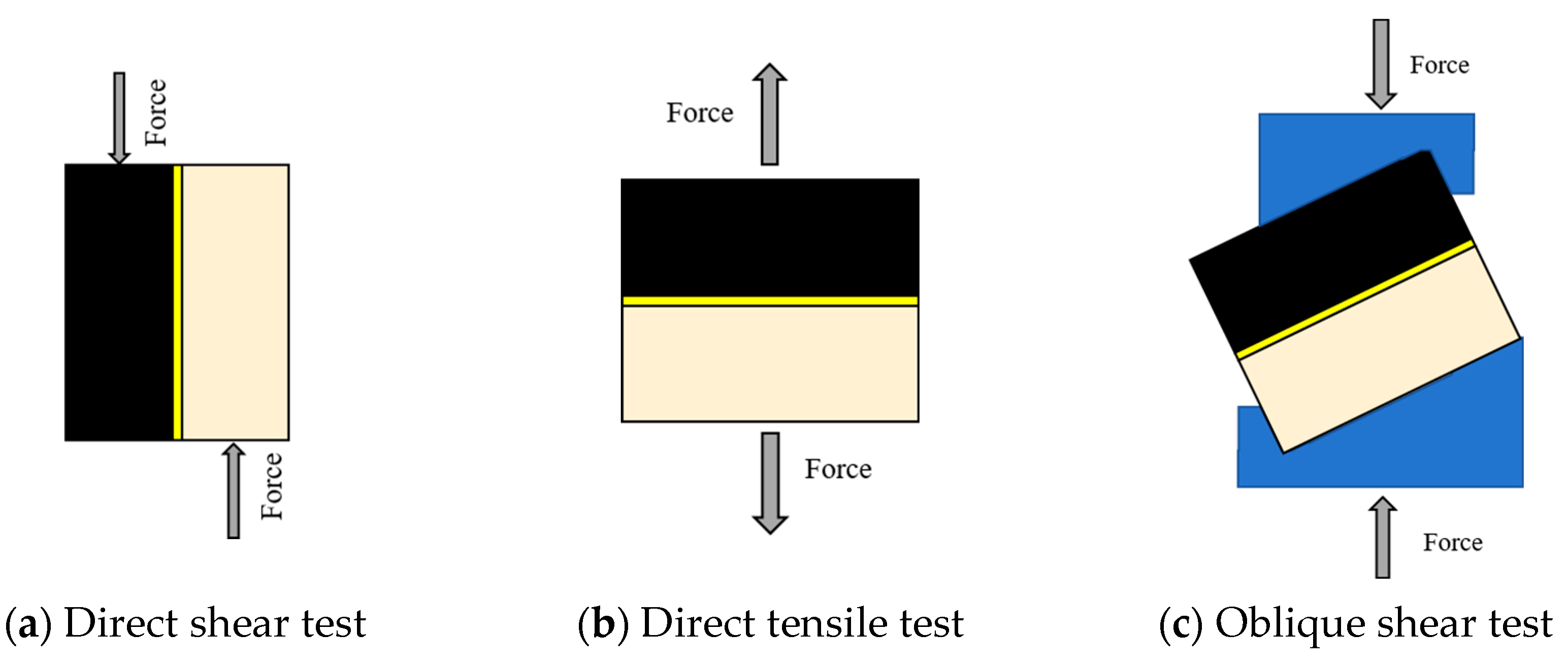


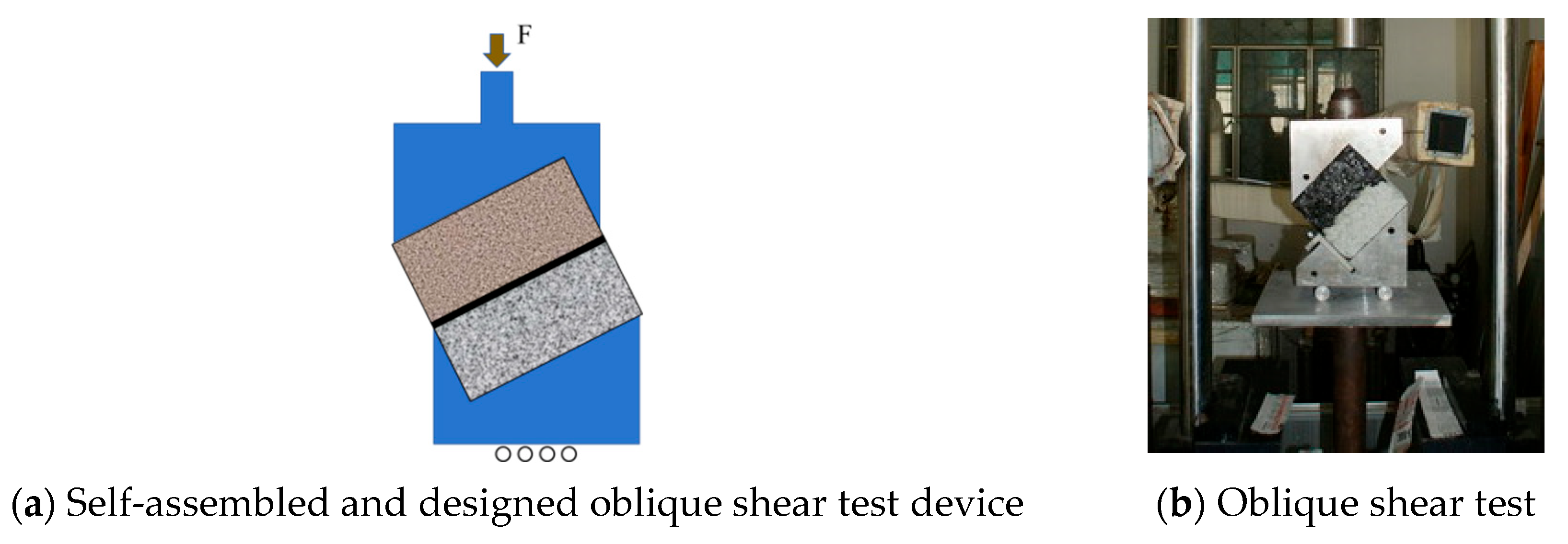
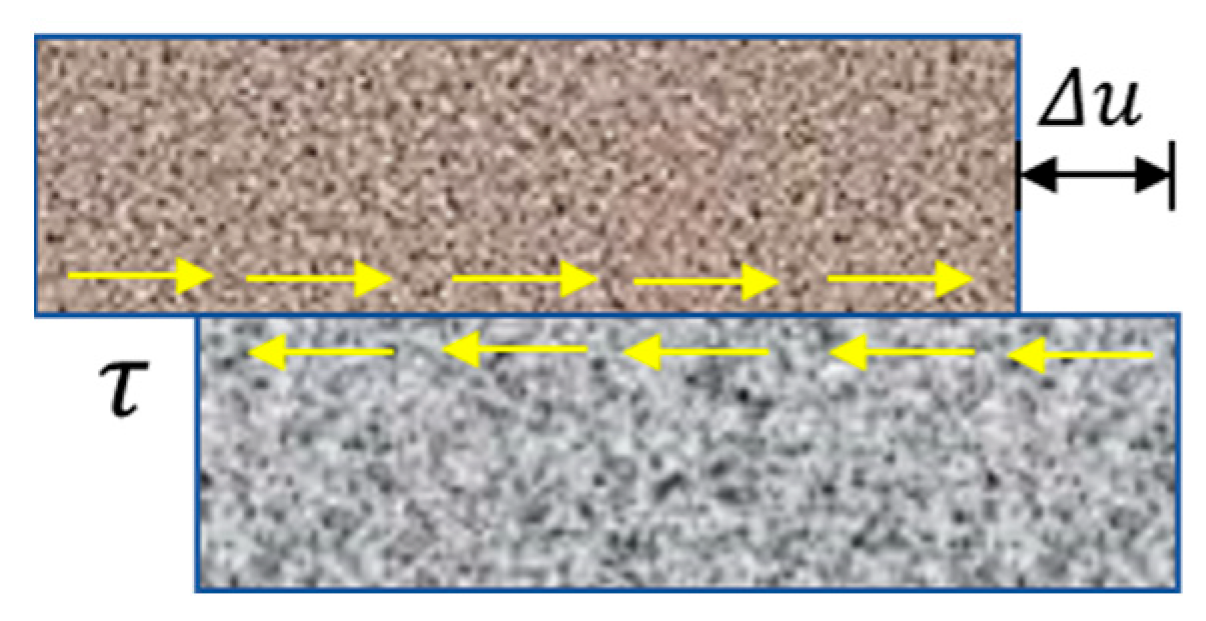

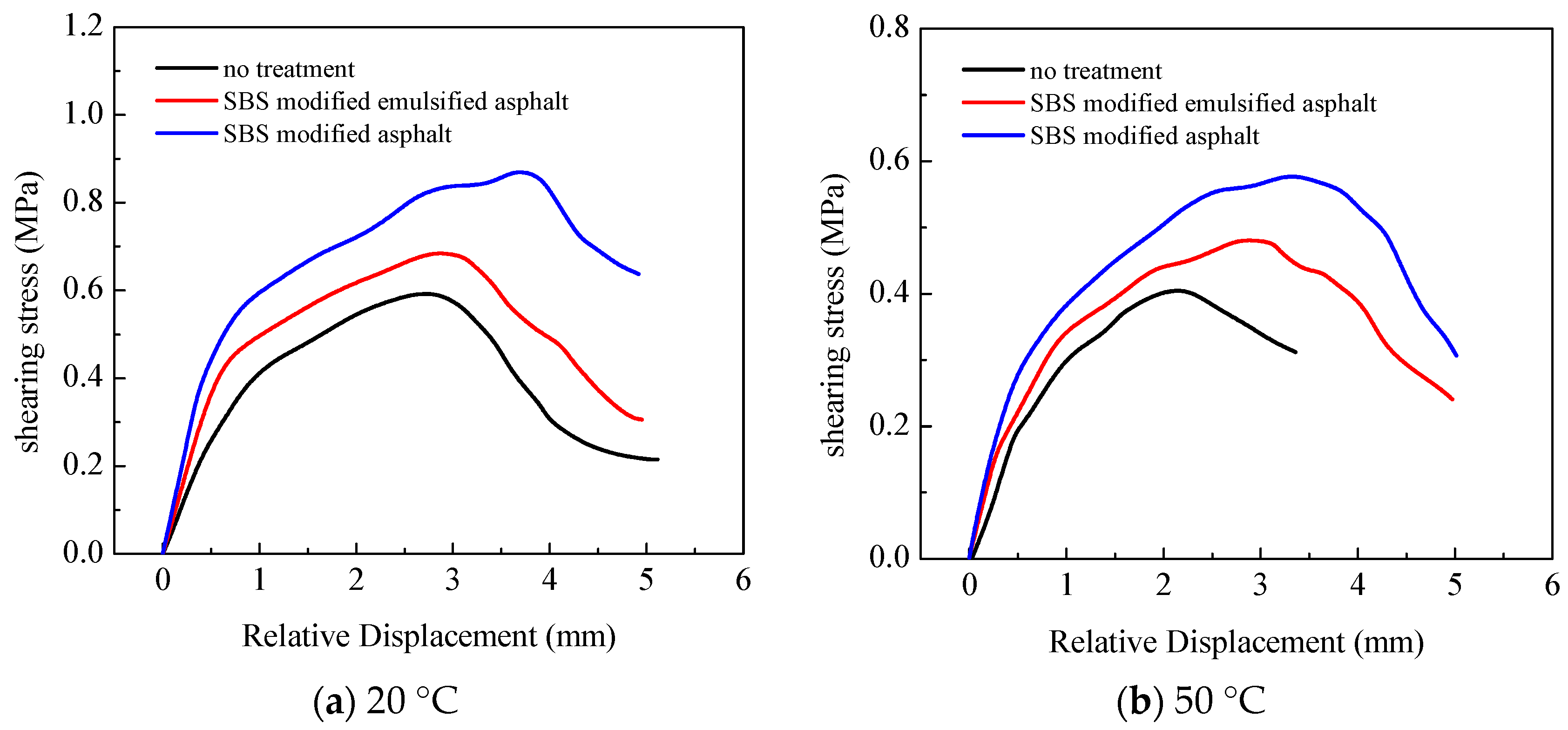
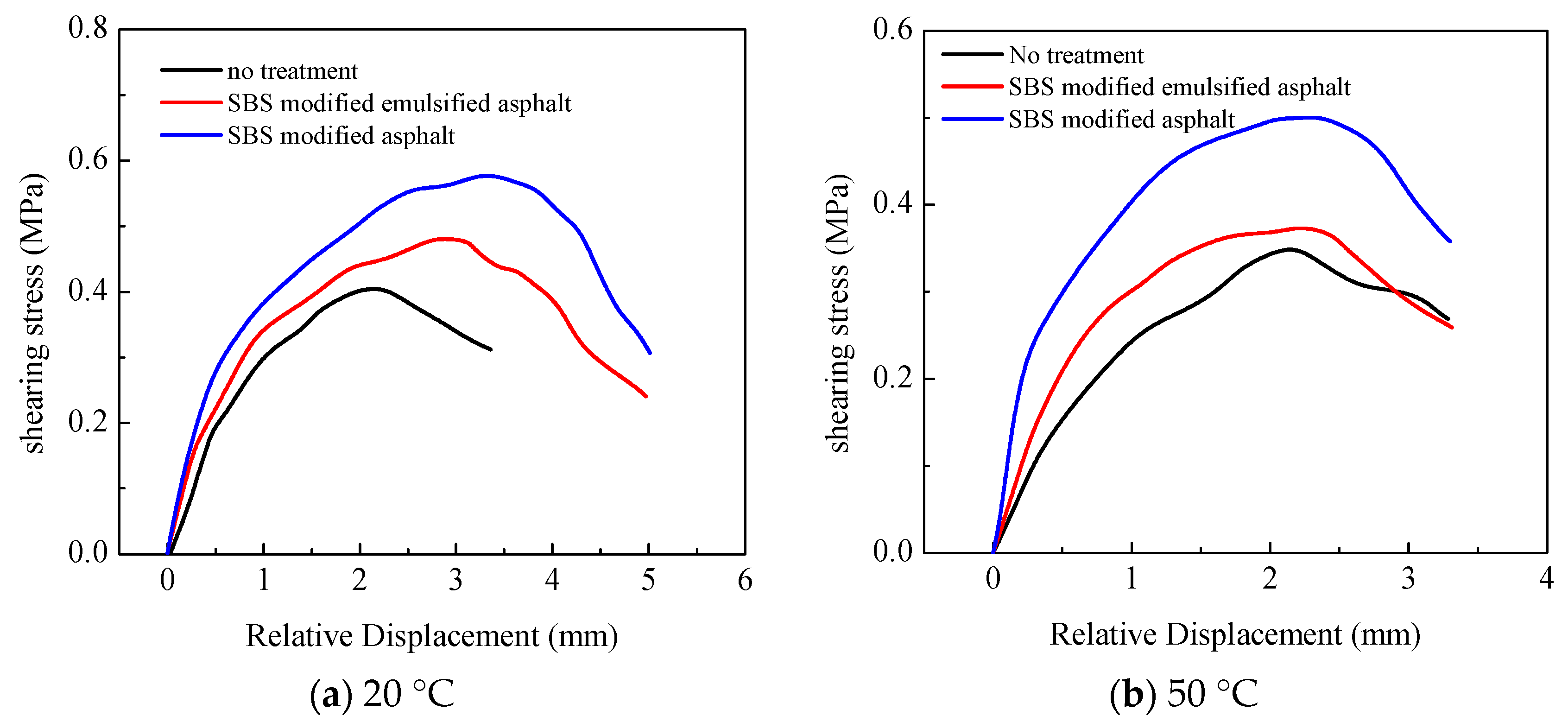
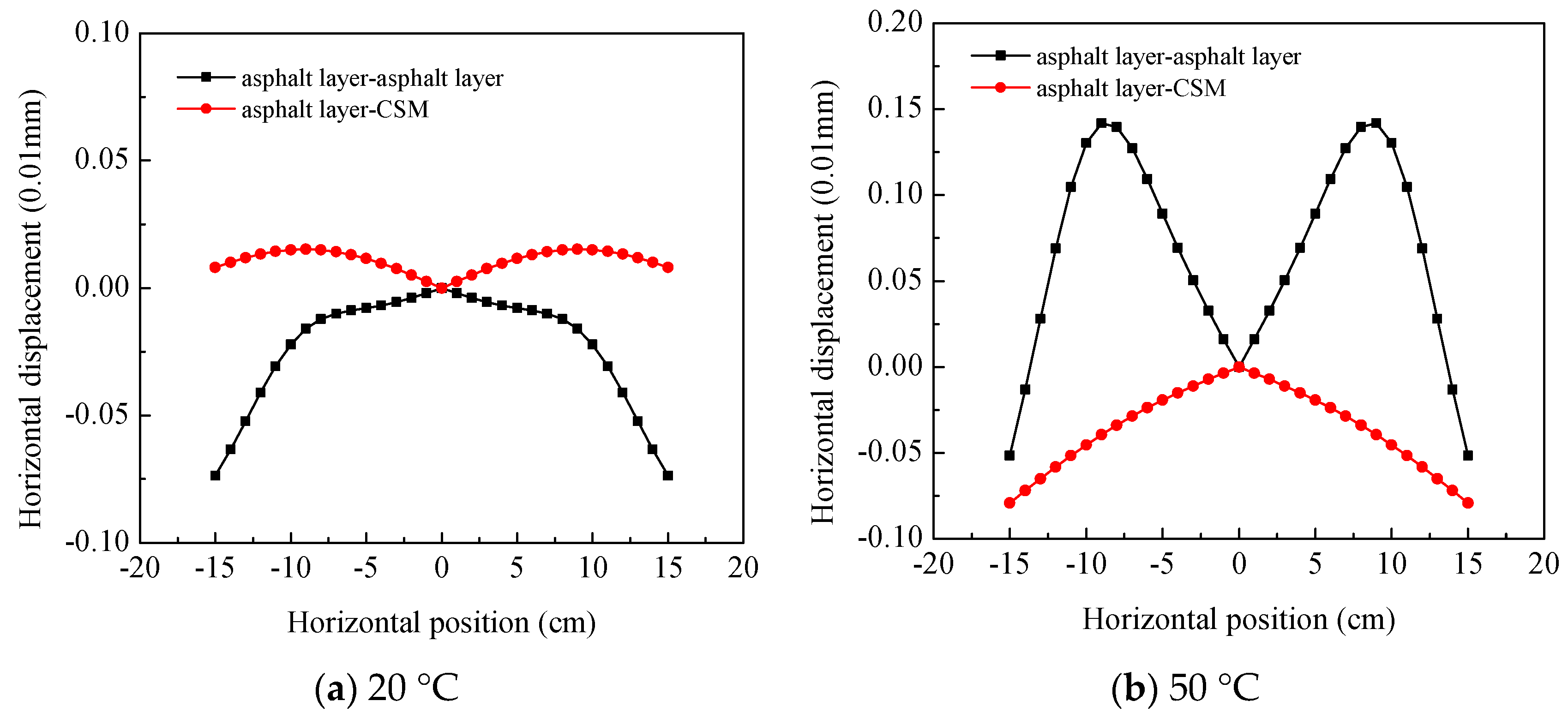
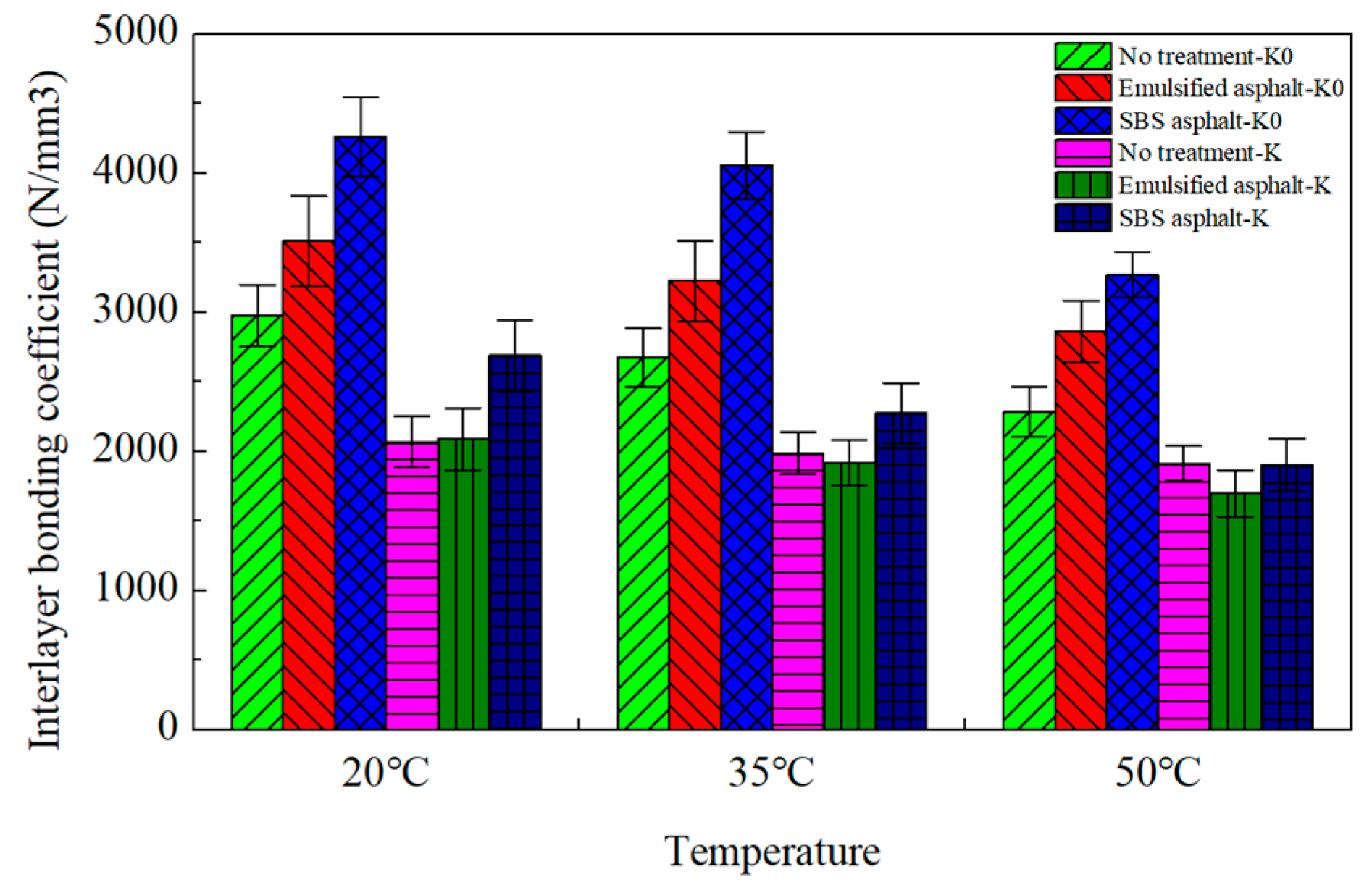
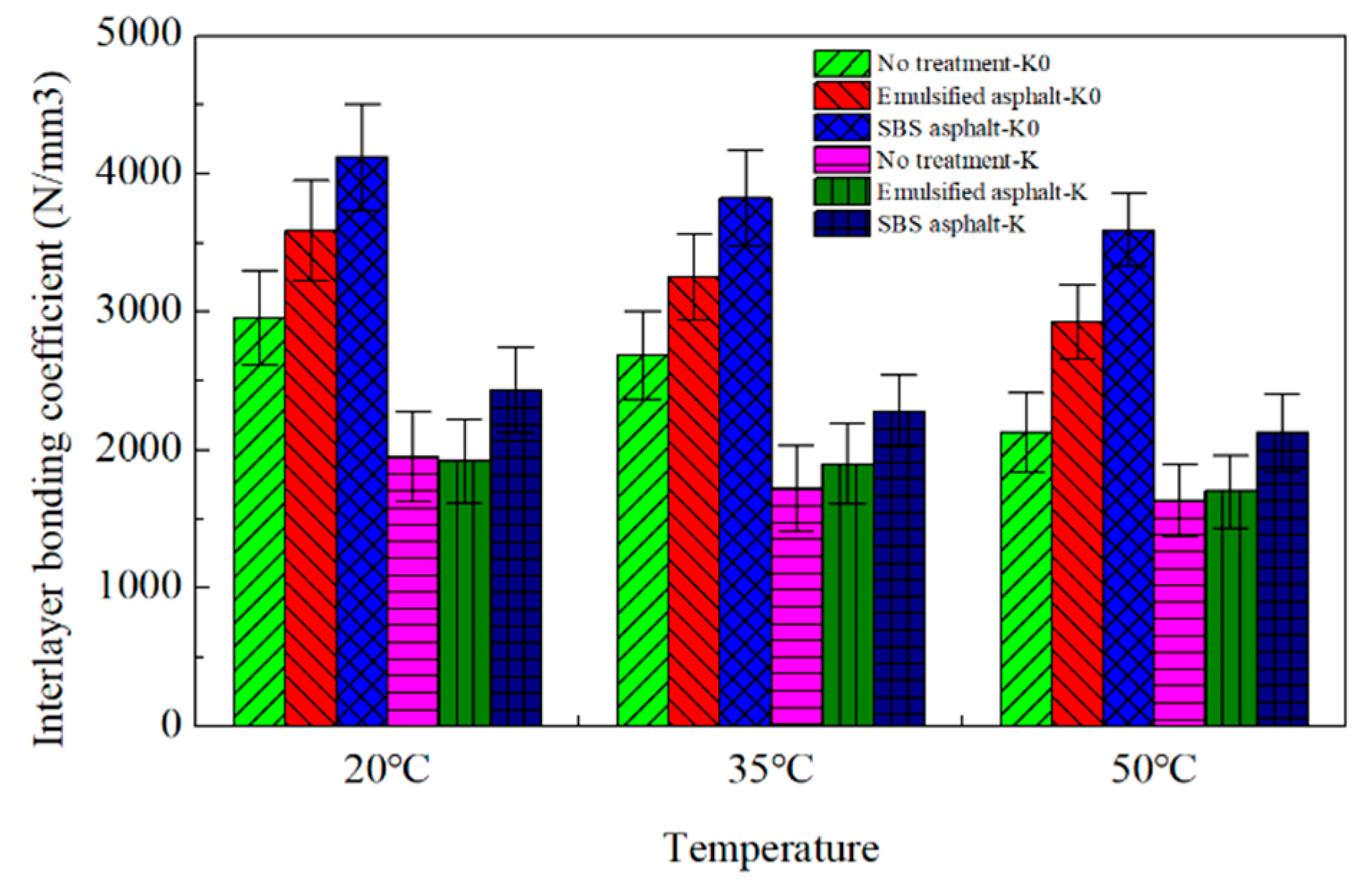

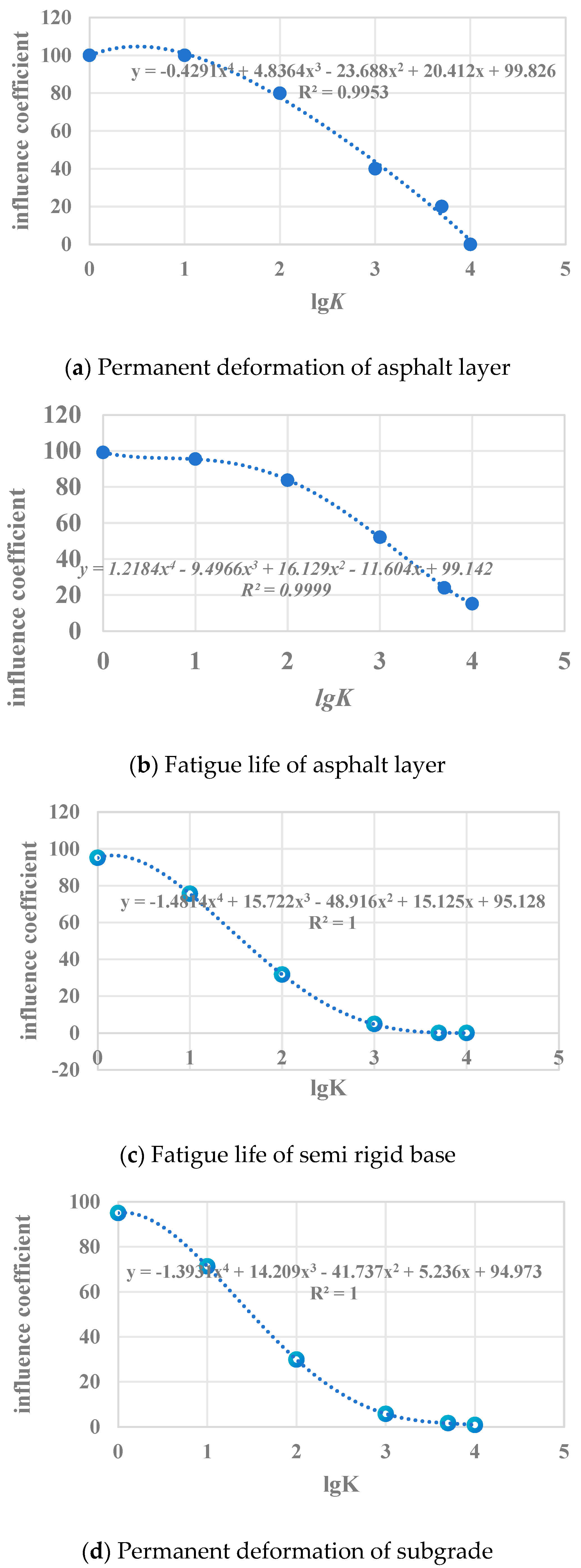
| Type | Sieve Size (mm) | 26.5 | 19 | 16 | 13.2 | 9.5 | 4.75 |
| SMA-13 | Passing (%) | 100 | 100 | 100 | 95 | 62.5 | 29 |
| AC-16 | Passing (%) | 100 | 100 | 95 | 84 | 71 | 50 |
| AC-20 | Passing (%) | 100 | 97.5 | 86.5 | 75 | 60 | 38 |
| Type | Sieve Size (mm) | 2.36 | 1.18 | 0.6 | 0.3 | 0.15 | 0.075 |
| SMA-13 | Passing (%) | 23 | 20 | 16 | 13 | 12 | 9.5 |
| AC-16 | Passing (%) | 37 | 26.5 | 18.5 | 12.5 | 9.5 | 6.5 |
| AC-20 | Passing (%) | 30 | 22 | 17 | 12.5 | 8 | 5 |
| Asphalt | SBS-Modified Asphalt |
|---|---|
| Penetration (25 °C), 0.1 mm | 73.4 |
| Ductility (cm) | 53.4 (5 °C) |
| Softening point (°C) | 86.7 |
| Emulsified Asphalt | Unit | Result | |
|---|---|---|---|
| Demulsification speed | fast | ||
| Particle charging | cation | ||
| Evaporation residue | Content | % | 52 |
| Penetration (100 g, 25 °C, 5 s) | 0.1 mm | 64 | |
| Softening point | °C | 54.2 | |
| Ductility (15 °C) | cm | >100 | |
| Storage stability (1 d)/% | °C | 0.55 | |
| Test Items | Standard Consistency Water Quantity (%) | Initial Setting Time | Final Setting Time |
|---|---|---|---|
| Result | 0.302 | 3 h 42 min | 5 h 34 min |
| Curing Time | 3 d | 7 d | 28 d |
|---|---|---|---|
| Flexural strength (MPa) | 3.4 | 4.8 | 8.6 |
| Compressive strength (MPa) | 13.1 | 18.8 | 35.6 |
| Sieve Size (mm) | 31.5 | 19 | 9.5 | 4.75 | 2.36 | 0.6 | 0.075 |
|---|---|---|---|---|---|---|---|
| Passing (%) | 100 | 95 | 70 | 39 | 23.5 | 13 | 2.5 |
| Temperature | Treatment Method | K0 | K | Bonding Strength (MPa) |
|---|---|---|---|---|
| 20 °C | No treatment | 2978 | 2071 | 0.59 |
| Emulsified asphalt | 3513 | 2090 | 0.69 | |
| SBS asphalt | 4260 | 2690 | 0.87 | |
| 35 °C | No treatment | 2675 | 1988 | 0.51 |
| Emulsified asphalt | 3225 | 1920 | 0.59 | |
| SBS asphalt | 4056 | 2277 | 0.71 | |
| 50 °C | No treatment | 2286 | 1915 | 0.40 |
| Emulsified asphalt | 2863 | 1699 | 0.48 | |
| SBS asphalt | 3265 | 1904 | 0.58 |
| Temperature | Treatment Method | K0 | K | Bonding Strength (MPa) |
|---|---|---|---|---|
| 20 °C | No treatment | 2960 | 1954 | 0.42 |
| Emulsified asphalt | 3591 | 1924 | 0.53 | |
| SBS asphalt | 4120 | 2438 | 0.64 | |
| 35 °C | No treatment | 2687 | 1725 | 0.39 |
| Emulsified asphalt | 3252 | 1904 | 0.40 | |
| SBS asphalt | 3825 | 2288 | 0.54 | |
| 50 °C | No treatment | 2130 | 1637 | 0.35 |
| Emulsified asphalt | 2932 | 1703 | 0.37 | |
| SBS asphalt | 3595 | 2128 | 0.50 |
| Material Properties | Thickness (cm) | Modulus (MPa) | Poisson’s Ratio |
|---|---|---|---|
| SMA-13 | 4 | 11,000 | 0.25 |
| AC-16 | 6 | 10,000 | 0.25 |
| AC-20 | 8 | 9000 | 0.25 |
| Cement-stabilized macadam | 18 | 16,000 | 0.25 |
| Cement-stabilized macadam | 20 | 12,000 | 0.25 |
| Graded aggregate base | 20 | 500 | 0.25 |
| Subgrade | — | 90 | 0.40 |
| Asphalt–CSM Layer Interlayer Bonding Coefficients | Asphalt–Asphalt Layer Interlayer Bonding Coefficients | ||||
|---|---|---|---|---|---|
| Complete Sliding | 2978 | 3513 | 4260 | Complete Bonding | |
| Complete sliding | 2.97 × 108 | 3.78 × 108 | 3.83 × 108 | 3.88 × 108 | 4.14 × 108 |
| 2960 | 8.69 × 1011 | 1.38 × 1012 | 1.42 × 1012 | 1.47 × 1012 | 1.73 × 1012 |
| 3591 | 1.55 × 1012 | 1.81 × 1012 | 1.87 × 1012 | 1.93 × 1012 | 2.27 × 1012 |
| 4120 | 2.53 × 1012 | 2.24 × 1012 | 2.31 × 1012 | 2.39 × 1012 | 2.80 × 1012 |
| Complete bonding | 3.13 × 1012 | 1.21 × 1013 | 1.25 × 1013 | 1.29 × 1013 | 1.51 × 1013 |
| Asphalt–CSM Layer Interlayer Bonding Coefficients | Asphalt–Asphalt Layer Interlayer Bonding Coefficients | ||||
|---|---|---|---|---|---|
| Complete Sliding | 2978 | 3513 | 4260 | Complete Bonding | |
| Complete sliding | 9.49 × 107 | 1.78 × 108 | 1.78 × 108 | 1.79 × 108 | 1.82 × 108 |
| 2960 | 8.44 × 108 | 1.73 × 109 | 1.73 × 109 | 1.74 × 109 | 1.76 × 109 |
| 3591 | 8.53 × 108 | 1.74 × 109 | 1.75 × 109 | 1.75 × 109 | 1.78 × 109 |
| 4120 | 8.60 × 108 | 1.76 × 109 | 1.76 × 109 | 1.77 × 109 | 1.79 × 109 |
| Complete bonding | 8.99 × 108 | 1.83 × 109 | 1.83 × 109 | 1.84 × 109 | 1.86 × 109 |
| Asphalt–CSM Layer Interlayer Bonding Coefficients | Asphalt–Asphalt Layer Interlayer Bonding Coefficients | ||||
|---|---|---|---|---|---|
| Complete Sliding | 2978 | 3513 | 4260 | Complete Bonding | |
| Complete sliding | 9.79 × 1011 | 1.55 × 1012 | 1.55 × 1012 | 1.56 × 1012 | 1.58 × 1012 |
| 2960 | 6.80 × 1012 | 1.59 × 1013 | 1.59 × 1013 | 1.60 × 1013 | 1.63 × 1013 |
| 3591 | 6.87 × 1012 | 1.61 × 1013 | 1.61 × 1013 | 1.62 × 1013 | 1.64 × 1013 |
| 4120 | 6.93 × 1012 | 1.62 × 1013 | 1.63 × 1013 | 1.63 × 1013 | 1.66 × 1013 |
| Complete bonding | 7.25 × 1012 | 1.71 × 1013 | 1.71 × 1013 | 1.72 × 1013 | 1.74 × 1013 |
| Asphalt–CSM Layer Interlayer Bonding Coefficients | Asphalt–Asphalt Layer Interlayer Bonding Coefficients | ||||
|---|---|---|---|---|---|
| Complete Sliding | 2978 | 3513 | 4260 | Complete Bonding | |
| Complete sliding | 5.73 | 4.68 | 4.66 | 4.63 | 4.52 |
| 2960 | 5.84 | 4.79 | 4.77 | 4.74 | 4.63 |
| 3591 | 5.84 | 4.80 | 4.77 | 4.75 | 4.63 |
| 4120 | 5.85 | 4.80 | 4.78 | 4.75 | 4.63 |
| Complete bonding | 5.86 | 4.82 | 4.79 | 4.76 | 4.65 |
| Performance of Asphalt Pavement | Interlayer Bonding Coefficient | |||||||
|---|---|---|---|---|---|---|---|---|
| Complete Sliding | 1 | 10 | 100 | 1000 | 5000 | 10,000 | Complete Bonding | |
| permanent deformation of asphalt layer | 2.80 | 2.80 | 2.80 | 2.81 | 2.83 | 2.84 | 2.85 | 2.85 |
| fatigue life of asphalt layer | 1.2 × 109 | 1.4 × 109 | 2.2 × 109 | 1.0 × 1010 | 6.0 × 1011 | 2.3 × 1013 | 7.1 × 1013 | 5.0 × 1014 |
| fatigue life of semi-rigid base | 3.4 × 109 | 3.5 × 109 | 4.3 × 109 | 6.6 × 109 | 8.6 × 109 | 9.0 × 109 | 9.0 × 109 | 9.0 × 109 |
| permanent deformation of subgrade | 1.2 × 1011 | 1.3 × 1011 | 2.1 × 1011 | 4.8 × 1011 | 7.7 × 1011 | 8.3 × 1011 | 8.5 × 1011 | 8.6 × 1011 |
| Performance of Asphalt Pavement | Interlayer Bonding Coefficient | |||||||
|---|---|---|---|---|---|---|---|---|
| Complete Sliding | 1 | 10 | 100 | 1000 | 5000 | 10,000 | Complete Bonding | |
| permanent deformation of asphalt layer | 100.0 | 100.0 | 100.0 | 80.0 | 40.0 | 20.0 | 0.0 | 0.0 |
| fatigue life of asphalt layer | 100.0 | 99.1 | 95.5 | 83.8 | 52.1 | 24.0 | 15.1 | 0.0 |
| fatigue life of semi rigid base | 100.0 | 95.1 | 75.6 | 31.7 | 4.9 | 0.0 | 0.0 | 0.0 |
| permanent deformation of subgrade | 100.0 | 95.0 | 71.3 | 29.9 | 5.8 | 1.7 | 0.8 | 0.0 |
| Pavement Performance | Permanent Deformation | Fatigue Life of Asphalt Layer | Fatigue Life of Semi-Rigid Base | Permanent Deformation of Subgrade |
|---|---|---|---|---|
| The control values of interlayer adhesion coefficient (MPa/cm) | ∞ | 5130 | 961 | 1191 |
Disclaimer/Publisher’s Note: The statements, opinions and data contained in all publications are solely those of the individual author(s) and contributor(s) and not of MDPI and/or the editor(s). MDPI and/or the editor(s) disclaim responsibility for any injury to people or property resulting from any ideas, methods, instructions or products referred to in the content. |
© 2025 by the authors. Licensee MDPI, Basel, Switzerland. This article is an open access article distributed under the terms and conditions of the Creative Commons Attribution (CC BY) license (https://creativecommons.org/licenses/by/4.0/).
Share and Cite
Guo, W.; Bai, Z.; Zhang, Q.; Tong, D.; Chen, S. Influence of Interlayer Bonding Conditions Between Base and Surface Layers on Structural Mechanics Response of Asphalt Pavements. Buildings 2025, 15, 2922. https://doi.org/10.3390/buildings15162922
Guo W, Bai Z, Zhang Q, Tong D, Chen S. Influence of Interlayer Bonding Conditions Between Base and Surface Layers on Structural Mechanics Response of Asphalt Pavements. Buildings. 2025; 15(16):2922. https://doi.org/10.3390/buildings15162922
Chicago/Turabian StyleGuo, Weijun, Zhanjun Bai, Qunfeng Zhang, Daizhou Tong, and Songqiang Chen. 2025. "Influence of Interlayer Bonding Conditions Between Base and Surface Layers on Structural Mechanics Response of Asphalt Pavements" Buildings 15, no. 16: 2922. https://doi.org/10.3390/buildings15162922
APA StyleGuo, W., Bai, Z., Zhang, Q., Tong, D., & Chen, S. (2025). Influence of Interlayer Bonding Conditions Between Base and Surface Layers on Structural Mechanics Response of Asphalt Pavements. Buildings, 15(16), 2922. https://doi.org/10.3390/buildings15162922





